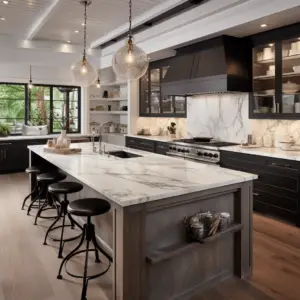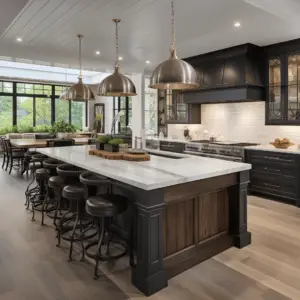Kitchen renovation, Renovating a kitchen can be challenging. But, follow the right steps and plan it out and it will become a functional and beautiful space. This article will give you tips and tricks to help you get the desired outcome.
You must first decide what you need and want for the kitchen. Think about style, budget, and functionality. Having an understanding of your needs helps you make better decisions.
Look at the layout and identify any areas needing improvement. This could include moving appliances, expanding storage, or creating work zones.
Also, updating features like countertops, cabinets, and appliances makes a big difference. Choose materials that match your style and think about maintenance when making selections.
Now, let’s take a look at the history of kitchen renovations. People started realizing the importance of an efficient kitchen centuries ago. Technology and design have improved over time, transforming kitchens from simple cooking areas to socializing and entertaining hubs.
Table of Contents
Assessing the current kitchen layout

Let’s take a look at the kitchen layout!
Examining the Kitchen Layout
| Aspect | Observation |
|---|---|
| Space allocation | Enough space for moving and appliances. |
| Workflow | Flow between cooking, prepping and cleaning. |
| Storage | Cabinets and pantry space for organization. |
| Lighting | Right fixtures for task lighting. |
| Safety | Identifying any potential hazards or old electrical connections. |
It’s important to consider these aspects. You may even discover special features or architectural elements that could make your design look better.
To make sure you make your kitchen perfect, get help from experts in kitchen renovations. They can help you with everything, from concept to execution.
Don’t miss this chance to make a dream kitchen that fits your needs and style. Act now and start this exciting journey!
Setting a budget
Ready to renovate your kitchen? Make sure you first determine your financial limit. Assess your budget and make sure it is realistic and affordable.
Conduct research into the costs of materials, appliances, labor, and more. This will give you insight into potential expenses.
Now, prioritize your needs. Identify what is non-negotiable and allocate funds accordingly.
Remember, there may be hidden costs. Think permits, structural changes, or any issues that may arise during the renovation process.
Don’t forget to get multiple quotes from different contractors. Compare prices and get the best value for your money.
Finally, allow room for contingency. Set aside some money just in case you need to cover additional expenses.
A survey by Houzz (2020) found that the average kitchen renovation costs around $35,000.
Planning the renovation process
- Assess your needs. Evaluate your kitchen and decide which changes are needed. Consider functionality, storage, and design. This assessment is key!
- Set a budget. Decide how much you’re willing to spend. Factor in labor, materials, and extra costs.
- Find inspiration. Research kitchen designs that match your vision. Look through magazines, online platforms, and showrooms. Get ideas for colors, cabinets, countertops, and appliances.
- Think practical. Consider the timeline of the renovation and how it will affect your daily routine. Plan each aspect carefully.
- Did you know? Kitchen renovations can increase the value of a home. According to Remodeling Magazine, homeowners typically recoup 77% of the cost when selling their property.
Selecting materials and appliances
When renovating a kitchen, selecting the right materials and appliances is essential. This choice will influence the look and purpose of the space. Let’s look at some factors to take into account.
| Materials | Advantages | Concerns |
|---|---|---|
| Stainless steel appliances | Modern style | |
| Wood cabinets | Classic, rustic feeling |
Checking the table above, we can see that there are several options for materials and appliances. Each one brings its own advantages and concerns. For instance, stainless steel appliances provide a modern style, while wood cabinets give a classic, rustic feeling. Before making decisions, assess your personal style, budget, and maintenance necessities.
To make the selection easier, here are some tips:
- Look at the durability: Choose materials that can handle daily use, like quartz countertops or porcelain tiles. They are attractive and long-lasting.
- Assess energy efficiency: When selecting appliances, prioritize energy-efficient models. They will help the environment and save on utility bills.
- Estimate storage needs: Before selecting cabinet materials, figure out your storage needs. Limited space? Choose efficient solutions like pull-out drawers or corner cabinets.
- Match colors and textures: Ensure that the materials and appliances you pick go together in color schemes and textures. This combination will give the kitchen a beautiful look.
By looking at these tips, you can select materials and appliances that fit your tastes while improving the usefulness of your kitchen space. Remember to balance style and practicality for a successful renovation project.
Demolition and preparation
Kitchen renovation entails a crucial phase of demolition and preparation. It is the foundation for the entire project. Here’s a breakdown of what it involves:
- Clearing: Furniture, appliances, and cabinets must be removed.
- Disconnection: Plumbing, electrical, and gas connections must be safely disconnected.
- Structural: Walls, floors, and ceilings must be assessed for structural integrity.
- Demo Work: Unwanted structures or fixtures must be carefully demolished.
- Waste Removal: Debris and waste materials must be disposed of responsibly.
When engaging in demolition and preparation, remember to:
- Protect surrounding areas from dust and damage.
- Consult professionals or contractors for complicated tasks.
- Wear protective gear when using power tools or lifting heavy items.
Pro Tip: Before starting, document the current layout of your kitchen with photos. These visuals will help with planning your new design.
Renovation process
Renovating your kitchen is a complex process that requires functionality, style, and creativity. Here’s how to modernize your culinary space:
- Planning: Begin by dreaming up your ideal kitchen and plotting out every detail. Think of layout, storage, and appliances.
- Demolition: Clear away the old fixtures and surfaces for your new design. Be cautious to avoid harming any structural elements.
- Installation: Bring your dream to reality by installing cabinets, countertops, flooring, and lighting. Make sure everything is precisely measured and fitted.
As you go through the renovation, bear in mind certain key points. Materials can determine how your kitchen looks and lasts. Get professional help throughout to guarantee a perfect outcome.
Don’t miss this chance to craft your dream kitchen. Transform your space into a haven of culinary delights with a design that caters to your unique needs and tastes. Act now and revel in the joy of cooking in an upgraded kitchen!
Finishing touches
Add pendant lights above the kitchen island to create a focal point and light up the workspace. Under cabinet lighting can also give the room more warmth and depth.
Display decorative items, such as colorful ceramics or plants, on open shelves for a touch of personality. Match these items to the color scheme and style.
Replace old cabinet handles and drawer pulls with modern, sleek designs. Opt for finishes that match appliances and fixtures for a unified look.
Install blinds or curtains that offer privacy and let natural light in. Pick fabrics that can resist moisture and heat, such as faux wood blinds or cotton curtains.
Be unique with a statement backsplash or custom-made tiles. These special elements will make your kitchen renovation more outstanding, yet still give it a professional and polished finish.
You can also add floating shelves for extra storage, or a wine rack for wine fanatics. These extras serve practical uses and look attractive.
Choose finishing touches that fit with your overall design concept. Every suggestion adds texture, color, and functionality to your kitchen space, creating a unified and appealing atmosphere for cooking, eating, and entertaining.
Maintenance and care tips

Keep your kitchen looking like new with these helpful maintenance tips:
- Clean countertops with a non-abrasive cleaner to prevent staining and scratches.
- Wipe cabinets and drawers with a mild detergent solution to get rid of any grease or food residue.
- Use a stainless steel cleaner for stainless steel appliances to keep them shiny and fingerprint-free.
- Regularly check for plumbing leaks or drips to avoid water damage.
- Inspect grout between tiles every few months. Reseal or replace if necessary.
- Install good ventilation to reduce cooking odors, moisture, and grease buildup.
On top of that, don’t forget to dust ceiling fans and light fixtures. Also, pay attention to the condition of your cutting boards. Replace them if they become too worn, as deep grooves can harbor bacteria.
So, take action now and add these tasks to your routine. Caring for your kitchen now will save you time and money in the future. Enjoy a kitchen that’s beautiful and well-maintained for years to come!
Conclusion
Renovating a kitchen is no easy feat. Careful planning and execution are key to achieving a beautiful outcome. Here are the steps to follow:
- Assess the current layout and functionality of the kitchen. Identify areas that need improvement, and decide the scope of the renovation.
- Create a budget to manage costs effectively.
- Select the right materials and fixtures. Every detail should complement each other and bring the desired look to life.
- Hire skilled professionals like contractors, electricians, and plumbers for complex tasks.
- Don’t forget to consider functionality. Maximize storage space with pull-out drawers and adjustable shelves.
- Invest in energy-efficient appliances to reduce utility bills and be environmentally friendly.
- Remember that kitchens have evolved significantly over time, reflecting changes in design trends, technology advancements, and societal needs.
Frequently Asked Questions
FAQs: How to Renovate a Kitchen
1. What are the key steps to renovate a kitchen?
Answer: The key steps to renovate a kitchen include planning, budgeting, hiring professionals (if necessary), selecting materials and appliances, executing the renovation, and finalizing the details.
2. How do I create a budget for my kitchen renovation?
Answer: To create a budget, assess your needs and priorities, research the cost of materials and labor, determine any additional expenses, and allocate funds accordingly. It is advisable to keep a contingency budget for unexpected costs.
3. Should I hire professionals or can I renovate my kitchen myself?
Answer: It depends on your expertise, available time, and complexity of the renovation. While minor updates can be DIY projects, it is recommended to hire professionals for major renovations or if you lack the necessary skills.
4. How do I select the right materials and appliances?
Answer: Consider your design preferences, durability, maintenance requirements, and budget when choosing materials and appliances. Research different options, read reviews, and seek advice from experts to make informed decisions.
5. What are some common mistakes to avoid during a kitchen renovation?
Answer: Common mistakes to avoid include underestimating the budget, failing to plan for enough storage space, not considering proper lighting, overlooking ventilation needs, and neglecting to hire qualified professionals for complex tasks.
6. How long does a kitchen renovation typically take?
Answer: The duration of a kitchen renovation can vary based on the scale of the project. Generally, it can take anywhere from a few weeks to a few months. Factors such as planning, permits, availability of contractors, and unforeseen issues can influence the timeline.
